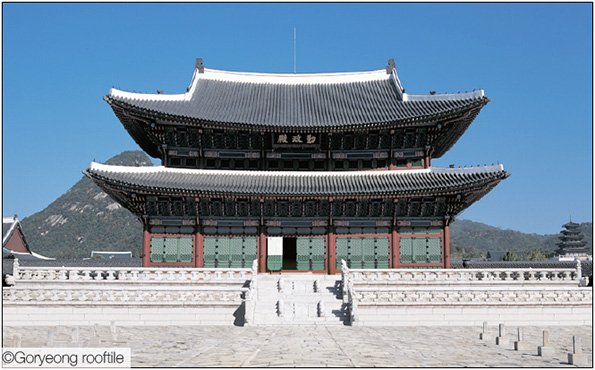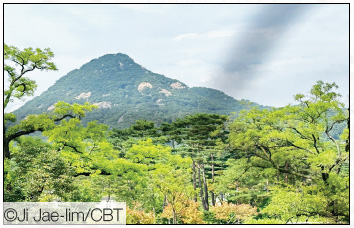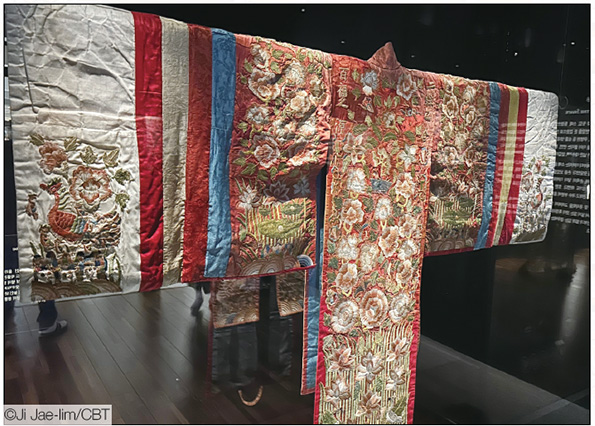
Like the Versailles Palace in France and Buckingham Palace in England, Korea also has one of the representative palaces of Korea, Gyeongbokgung Palace in the center of Seoul. Gyeongbokgung was constructed in 1395 during the Joseon Dynasty to be served as Joseon Dynasty’s main palace. It was once destroyed by fire during the Japanese Invasion of Korea in 1592 and reconstructed in 1867 by the Prince Regent at that time. After reconstruction, it survived through Japanese occupation and the Korean War, and it is now open to the public after many restorations. The Gyeongbokgung Palace Management Office is providing many special exhibitions and experimental programs to promote its own beauty and traditions. Thus, a CBT reporter will introduce the quaint atmosphere of Gyeongbokgung Palace and Gyeonghoeru Pavilion and the traditional women’s weddings by visiting the National Palace Museum of Korea right next door.
Gyeongbokgung Palace
During the weekend, Gyeongbokgung was crowded with many tourists and visitors. There were some people in normal clothes, however, there were many visitors wearing Korean traditional clothes Hanbok. Visitors who wear a Hanbok that meet the regulations, or are under or older than certain age, can enter free of charge. The reporter could enter for free since the reporter met the regulation of being a Korean citizen under 24.

The first spectacular building that visitors would encounter after entering through Heungnyemun Gate Compound and the Geunjeongmun Gate, is the Geunjeongjeon Hall. This is a Throne Hall Compound of Joseon Dynasty, as well as a National Treasure of Korea. It has a very high ceiling and was built on two-tier foundations giving the impression of much greater grandeur. When climbing up the steps on the foundation and looking at Geunjeongjeon closely, the reporter could feel the beauty of Korean historical sites which were different from modern buildings, and in harmony of Dancheong (Korean traditional coloring of wooden buildings and artifacts for eaves) with the sky. Entrance to the inside of the hall was forbidden to protect the historical site, but sightseeing at the doorstep was allowed. The inside of the hall was very large and opened to a high ceiling, while the king’s throne was located in the center at the back of the hall. This gave the reporter the chance to imagine the king sitting there and managing national his affairs. Because it is one of the most famous pavilions, on par with Gwanghwamun Gate and Gyeonghoeru Pavilion, there were a tremendous amount of domestic and foreign visitors taking photos and snapshots.
Gyeonghoeru Pavilion
After that, the reporter headed to Gyeonghoeru Pavilion Special Observation which was reserved a week in advance. Gyeonghoeru opens its inside to a maximum of 35 visitors four times a day during the summer season except July. At first, the visitors gathers on the first floor with a guide and the program starts with an informative talk about Gyeongbokgung and Gyeonghoeru. Gyeonghoeru was used for feasts for foreign envoys, for the king and his court officials, and rituals for rain. It is located in the artificial pond in Gyeongbokgung and built as two floors, so that people can enjoy the wonderful view from the second floor. The first floor is an open space with pillars. There were originally dragon and flower patterns sculpted on the pillars. However, after it was destroyed during the Japanese Invasion of Korea in 1592, it was unfortunately not possible to restore the original sculpture. Also, the scars all over the pillars are traces of the Korean War in the form of bullet holes. Furthermore, a huge casted dragon was discovered in the artificial pond and it is now displayed in the National Palace Museum of Korea, giving visitors a chance to enjoy an exhibition afterwards.

After a few minutes of explanation, visitors could finally go upstairs. At the second floor, the windows in all sides were fully opened. This cooled down the building while offering an unrestricted view of the surroundings. Through the open windows, the views of Gyeongbokgung, Inwangsan Mountain and Bugaksan Mountain could be enjoyed.
It was interesting to note second floor has three sections separated by two thresholds and a low stair. The ancients separated the sitting sections for kings and the royal family and the vassals and there was a dedicated pathway for servants who prepared and served the food. The CBT reporter walked into the very inner section which is for king and royal family, and noticed different Dancheong patterns on the ceiling. The Dancheong from first and second floor’s ceiling was different, and for the second floor, each section even had different Dancheong. This helps visitors to appreciate and admire the beauty that ancients pursued.
As the exhibition was restricted to 40 minutes including the guide’s explanation, the time passed rather quickly. After this, the reporter moved deep inside Gyeongbokgung and could see the large site of Gyeongbokgung which has not been restored yet after disaster and fire. Previously, the guide from Gyeonghoeru showed some regrets over this and mentioned that there are currently only 36 of the original 500 buildings which survived. There were free guide tours for visitors in few languages, provided by Gyeongbokgung Palace Management Office at certain times during the day. The reporter missed the tour, but it was not a problem because there were many signs and explanation here and there in the palace for those visitors who missed the guided tours.
Blooming Hwarot: Bridal Robes of the Joseon Royal Court
Blooming Hwarot is a special exhibition offered by the National Palace Museum of Korea until Dec. 31. Visitors will have the opportunity to see Hwarots worn by Joseon’s princesses for their weddings and other stuffs used in traditional wedding. The word Hwarot appeared in history from modern times, but it originally referred to a wedding robe, Hongjangsam (bridal robe). It had spread to the public and became generalized as a bridal robe over the years. Now, it had been a typical wedding robe when people think of traditional wedding.

In this exhibition, the museum introduced not only women’s traditional wedding attire, but also various fancy Hwarot designs with all different patterns from different times. The color of the Hwarot looked faded because condition, storing method and time of sewing were all different. However, this Hongjangsam was made of the very precious red color on the silk and has various colors of sleeves and tight embroidery without any overlapping, that shows the heartfelt love from bride’s family.
Through this visit, the reporter had the opportunity to discover the beauty of Joseon in the past and the royal Joseon family. Like the reporter did at that time, how about following the traces of Joseon’s royal family? If readers visit there, they can have interesting experience and enjoy something extraordinary.
By Ji Jae-lim
jlim0714@chungbuk.ac.kr


 All
All Experience
Experience






 Ji Jae-lim
Ji Jae-lim











